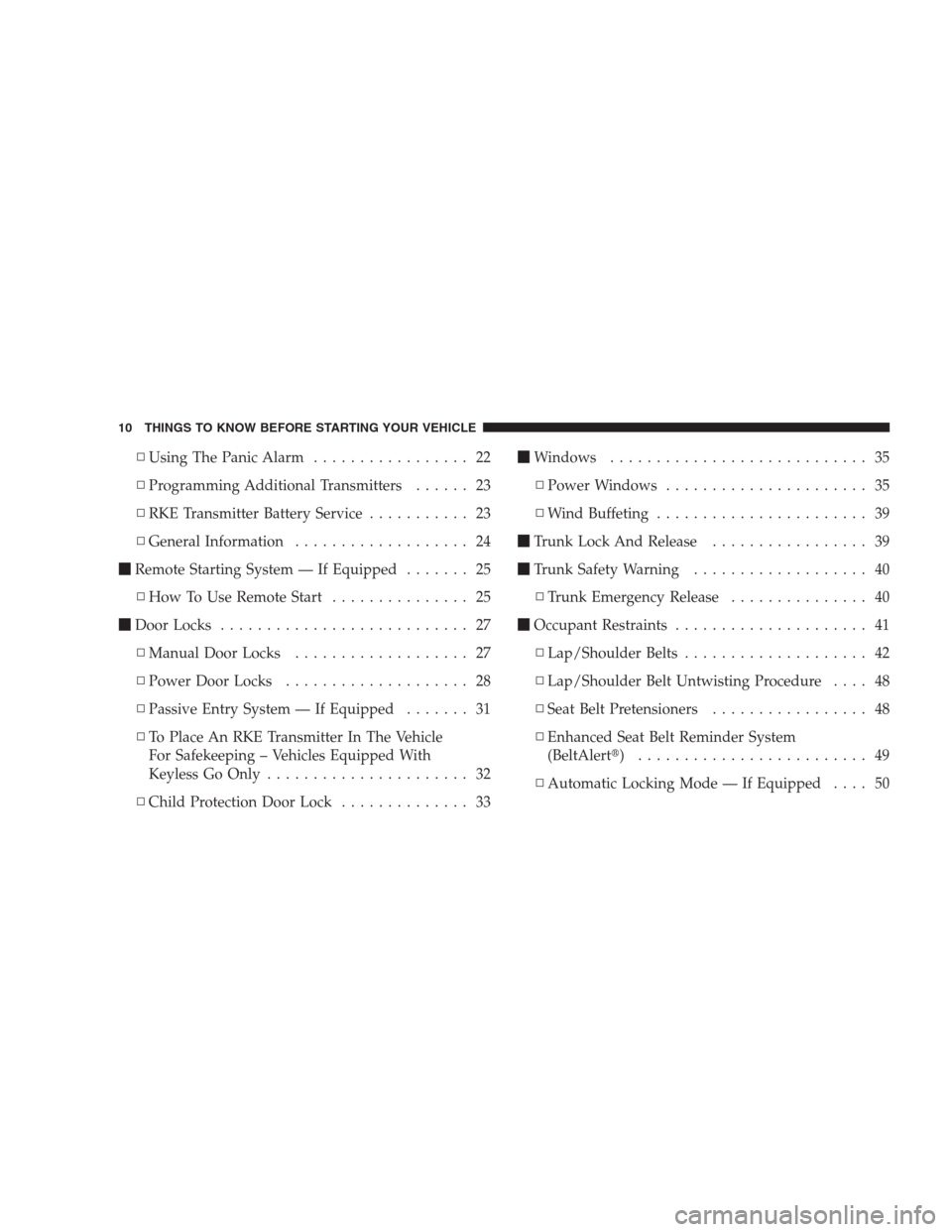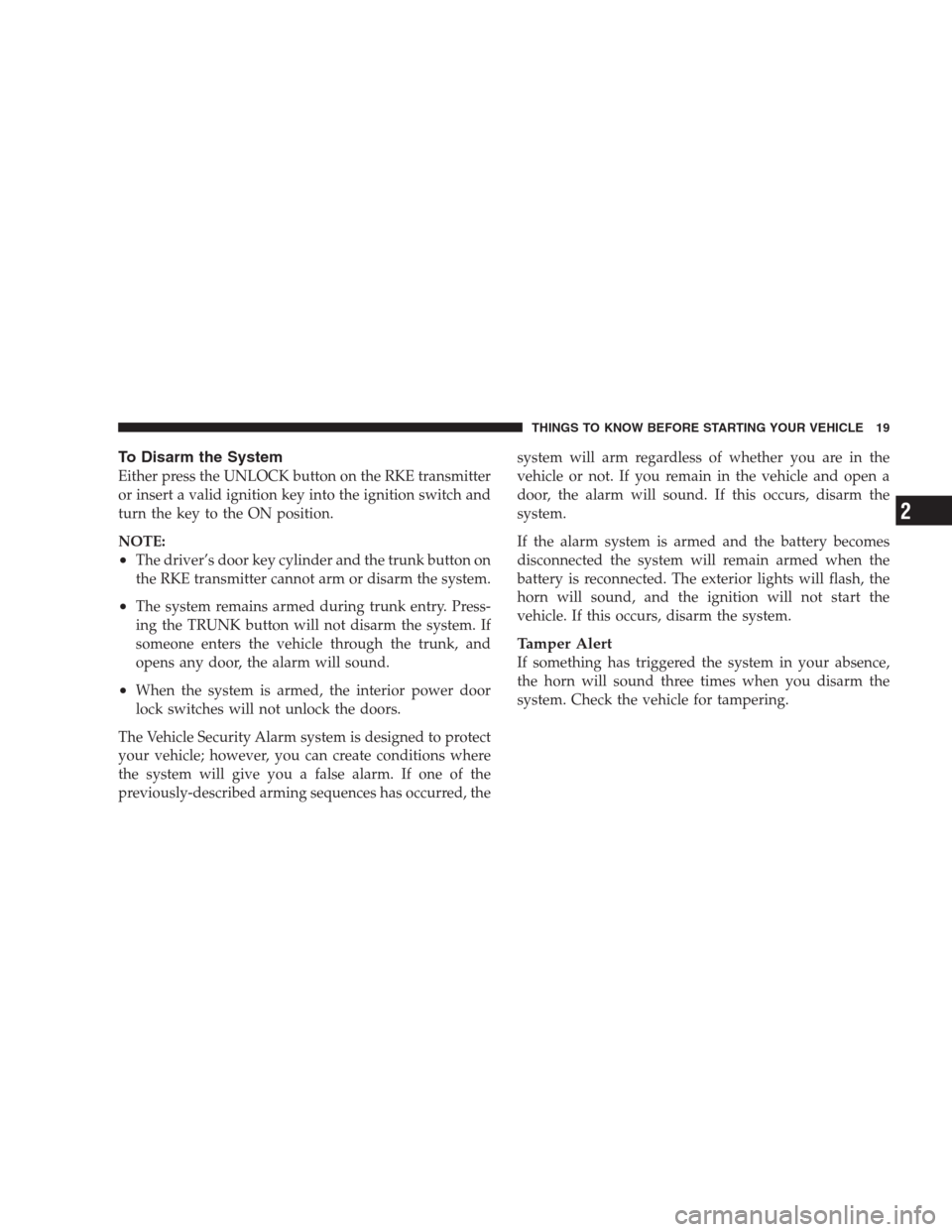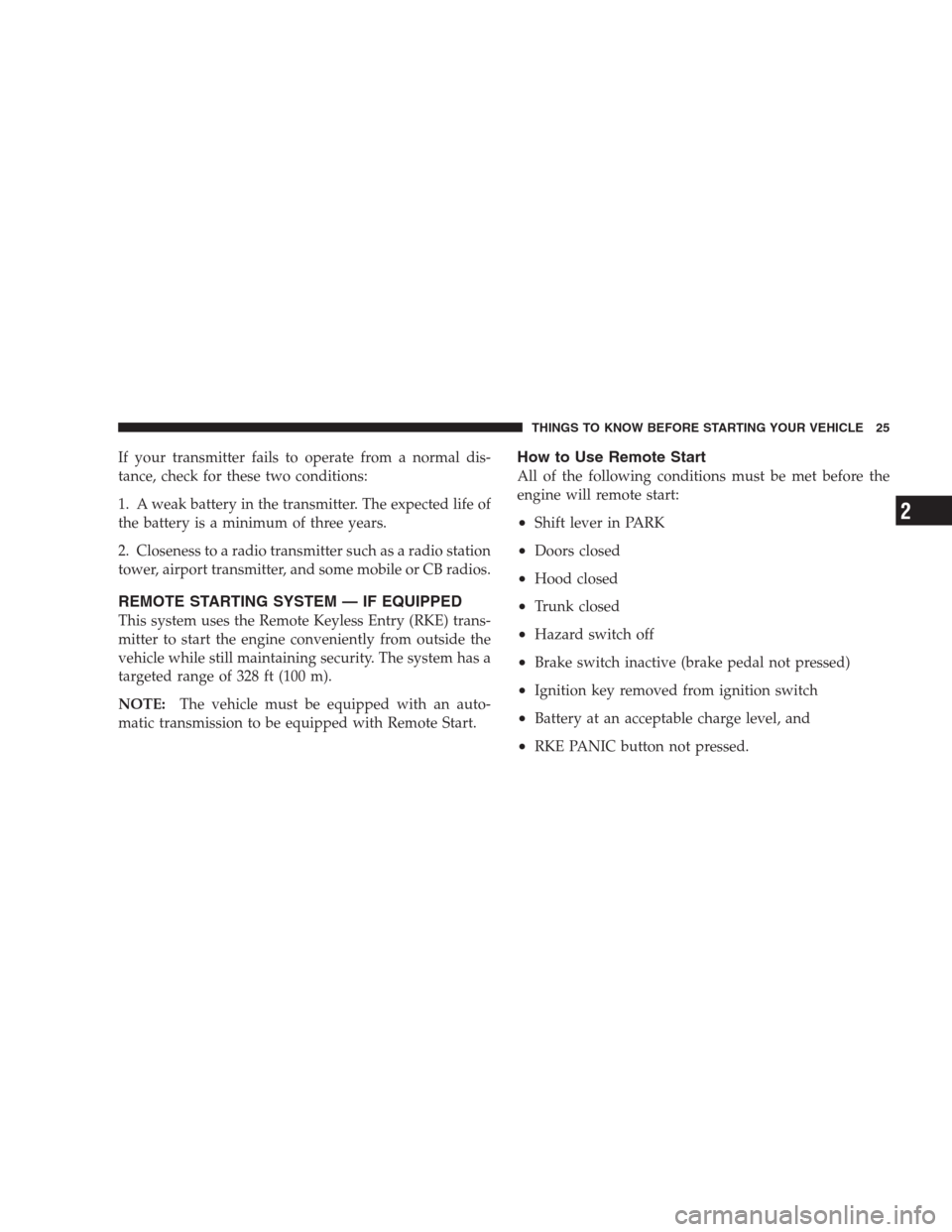Page 12 of 493

▫Using The Panic Alarm................. 22
▫Programming Additional Transmitters...... 23
▫RKE Transmitter Battery Service........... 23
▫General Information................... 24
�Remote Starting System — If Equipped....... 25
▫How To Use Remote Start............... 25
�Door Locks........................... 27
▫Manual Door Locks................... 27
▫Power Door Locks.................... 28
▫Passive Entry System — If Equipped....... 31
▫To Place An RKE Transmitter In The Vehicle
For Safekeeping – Vehicles Equipped With
Keyless Go Only...................... 32
▫Child Protection Door Lock.............. 33�Windows............................ 35
▫Power Windows...................... 35
▫Wind Buffeting....................... 39
�Trunk Lock And Release................. 39
�Trunk Safety Warning................... 40
▫Trunk Emergency Release............... 40
�Occupant Restraints..................... 41
▫Lap/Shoulder Belts.................... 42
▫Lap/Shoulder Belt Untwisting Procedure.... 48
▫Seat Belt Pretensioners................. 48
▫Enhanced Seat Belt Reminder System
(BeltAlert�) ......................... 49
▫Automatic Locking Mode — If Equipped.... 50
10 THINGS TO KNOW BEFORE STARTING YOUR VEHICLE
Page 15 of 493
Fob with Integrated Key
The Fob with Integrated Key (FOBIK) operates the igni-
tion switch. It also contains the Remote Keyless Entry
(RKE) transmitter and a valet key, which stores in the rear
of the Fob.
The valet key allows for entry into the vehicle should the
battery in the vehicle or the Fob go dead. The valet key is
also for locking the glove box. You can keep the valet key
with you when valet parking.
To remove the valet key from the Fob, slide the mechani-
cal latch at the top of the Fob sideways with your thumb
and then pull the key out of the Fob with your other
hand.NOTE:You can insert the double-sided valet key into
the lock cylinders with either side up.
Valet Key Removal
THINGS TO KNOW BEFORE STARTING YOUR VEHICLE 13
2
Page 21 of 493

To Disarm the System
Either press the UNLOCK button on the RKE transmitter
or insert a valid ignition key into the ignition switch and
turn the key to the ON position.
NOTE:
•The driver’s door key cylinder and the trunk button on
the RKE transmitter cannot arm or disarm the system.
•The system remains armed during trunk entry. Press-
ing the TRUNK button will not disarm the system. If
someone enters the vehicle through the trunk, and
opens any door, the alarm will sound.
•When the system is armed, the interior power door
lock switches will not unlock the doors.
The Vehicle Security Alarm system is designed to protect
your vehicle; however, you can create conditions where
the system will give you a false alarm. If one of the
previously-described arming sequences has occurred, thesystem will arm regardless of whether you are in the
vehicle or not. If you remain in the vehicle and open a
door, the alarm will sound. If this occurs, disarm the
system.
If the alarm system is armed and the battery becomes
disconnected the system will remain armed when the
battery is reconnected. The exterior lights will flash, the
horn will sound, and the ignition will not start the
vehicle. If this occurs, disarm the system.
Tamper Alert
If something has triggered the system in your absence,
the horn will sound three times when you disarm the
system. Check the vehicle for tampering.
THINGS TO KNOW BEFORE STARTING YOUR VEHICLE 19
2
Page 25 of 493
NOTE:
•The interior lights will turn off if you turn the ignition
switch to the ACC or ON position while the Panic
Alarm is activated. However, the exterior lights and
horn will remain on.
•You may need to be less than 35 ft (11 m) from the
vehicle when using the transmitter to turn off the
Panic Alarm due to the radio frequency noises emitted
by the system.
Programming Additional Transmitters
Refer to Sentry Key�, “Customer Key Programming.”
If you do not have a programmed RKE transmitter,
contact your authorized dealer for details.
RKE Transmitter Battery Service
The recommended replacement battery is one CR2032
battery.
NOTE:
•Perchlorate Material — special handling may apply.
See www.dtsc.ca.gov/hazardouswaste/perchlorate
•Do not touch the battery terminals that are on the back
housing or the printed circuit board.
THINGS TO KNOW BEFORE STARTING YOUR VEHICLE 23
2
Page 26 of 493
1. Battery access is through a door located on the rear of
the fob. Insert a small, flat blade screwdriver into the slot
and gently pry open the access door.2. Remove and replace the batteries. Avoid touching the
new batteries with your fingers. Skin oils may cause
battery deterioration. If you touch a battery, clean it with
rubbing alcohol.
3. Reposition the access door panel over the battery
opening and snap into place.
General Information
This device complies with Part 15 of the FCC rules and
RSS 210 of Industry Canada. Operation is subject to the
following conditions:
•This device may not cause harmful interference.
•This device must accept any interference received,
including interference that may cause undesired
operation.
NOTE:Changes or modifications not expressly ap-
proved by the party responsible for compliance could
void the user’s authority to operate the equipment.
Battery Replacement
1— Battery Access Door 24 THINGS TO KNOW BEFORE STARTING YOUR VEHICLE
Page 27 of 493

If your transmitter fails to operate from a normal dis-
tance, check for these two conditions:
1. A weak battery in the transmitter. The expected life of
the battery is a minimum of three years.
2. Closeness to a radio transmitter such as a radio station
tower, airport transmitter, and some mobile or CB radios.
REMOTE STARTING SYSTEM — IF EQUIPPED
This system uses the Remote Keyless Entry (RKE) trans-
mitter to start the engine conveniently from outside the
vehicle while still maintaining security. The system has a
targeted range of 328 ft (100 m).
NOTE:The vehicle must be equipped with an auto-
matic transmission to be equipped with Remote Start.
How to Use Remote Start
All of the following conditions must be met before the
engine will remote start:
•Shift lever in PARK
•Doors closed
•Hood closed
•Trunk closed
•Hazard switch off
•Brake switch inactive (brake pedal not pressed)
•Ignition key removed from ignition switch
•Battery at an acceptable charge level, and
•RKE PANIC button not pressed.
THINGS TO KNOW BEFORE STARTING YOUR VEHICLE 25
2
Page 40 of 493
Window Lockout Switch
The window lockout switch on the driver’s door trim
panel allows you to disable the window controls on the
passenger doors. To disable the window controls, press
and release the window lockout button (setting it in the
DOWN position). To enable the window controls, press
and release the window lockout button again (setting it in
the UP position).
Reset
Anytime the vehicle battery is disconnected or goes dead,
the AUTO-up function will be disabled. To reactivate the
AUTO-up feature, perform the following procedure after
vehicle power is restored:
Window Lockout Switch
38 THINGS TO KNOW BEFORE STARTING YOUR VEHICLE
Page 64 of 493

However, if you haven’t healed significantly within a
few days or if you have any blistering, see your doctor
immediately.
•As the airbags deflate, you may see some smoke-like
particles. The particles are a normal by-product of the
process that generates the nontoxic gas used for airbag
inflation. These airborne particles may irritate the skin,
eyes, nose, or throat. If you have skin or eye irritation,
rinse the area with cool water. For nose or throat
irritation, move to fresh air. If the irritation continues,
see your doctor. If these particles settle on your
clothing, follow the garment manufacturer’s instruc-
tions for cleaning.
•It is not advisable to drive your vehicle after the
airbags have been deployed. If you are involved in
another collision, the airbags will not be in place to
protect you.
WARNING!
Deployed airbags can’t protect you in another colli-
sion. Have the airbags replaced by an authorized
dealer as soon as possible.
Enhanced Accident Response System
In the event of an impact that causes airbag deployment,
with the vehicle stopped, and the vehicle communication
network intact, and the power intact, the Enhanced
Accident Response System performs the following func-
tions:
•Cuts off fuel to the engine.
•Flashes hazard lights.
•Turns on the interior lights, which remain on as long as
the battery has power or until the ignition key is
removed.
•Unlocks the doors automatically.
62 THINGS TO KNOW BEFORE STARTING YOUR VEHICLE